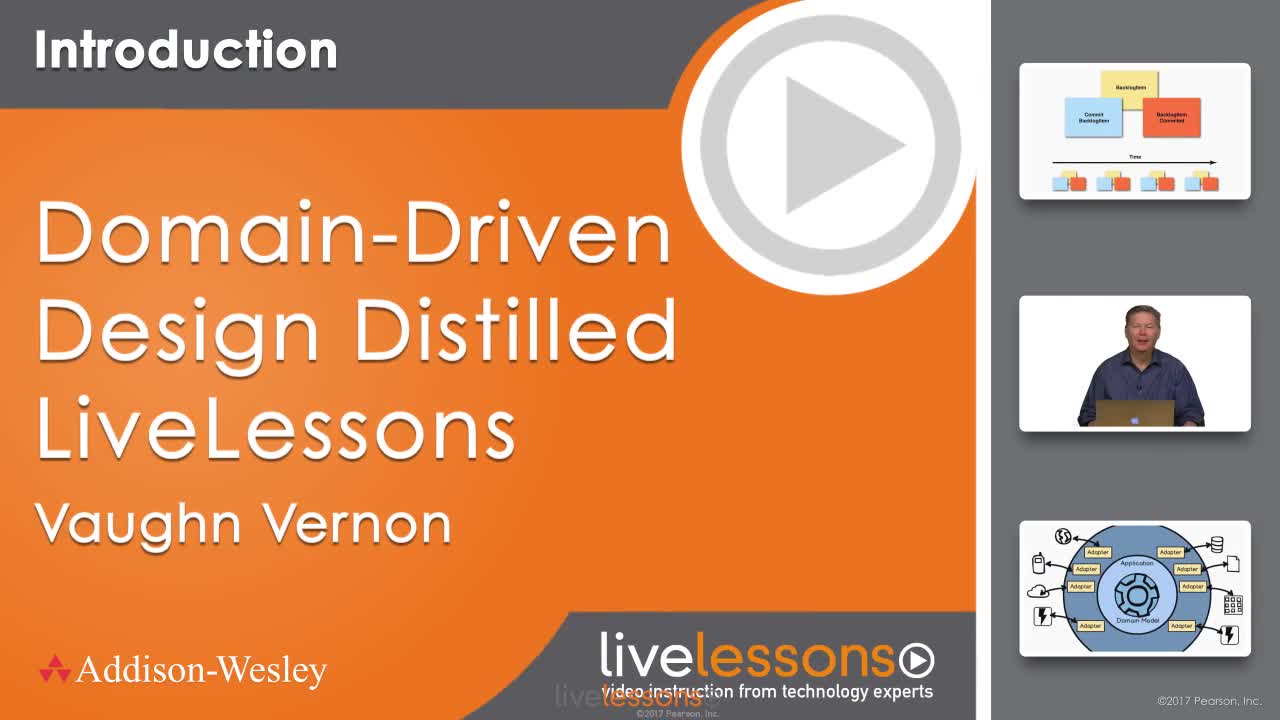Domain-Driven Design LiveLessons (Video Training)
- By Vaughn Vernon
- Published Apr 5, 2017 by Addison-Wesley Professional. Part of the LiveLessons series.
Online Video
- Your Price: $239.99
- List Price: $299.99
- About this video
Video accessible from your Account page after purchase.
Register your product to gain access to bonus material or receive a coupon.
Description
- Copyright 2017
- Edition: 1st
- Online Video
- ISBN-10: 0-13-459732-X
- ISBN-13: 978-0-13-459732-4
4 Hours of Video Instruction
Domain-Driven Design (DDD) software modeling delivers powerful results in practice, not just in theory, which is why developers worldwide are rapidly moving to adopt it.Domain-Driven Design Distilled LiveLessons video training, based on the bestselling book Domain-Driven Design Distilled, covers the basics of DDD including: what it is, what problems it solves, how it works, and how to quickly gain value from it. This training focuses on what you need to know about DDD to get results.
Vaughn Vernon draws on several years of experience applying DDD to real-world situations. He is uniquely well-qualified to demystify its complexities, illuminate its subtleties, and help you solve the problems you might encounter.
Vernon guides you through each core DDD technique for building better software. You’ll learn how to segregate domain models using the powerful Bounded Contexts pattern, to develop a Ubiquitous Language within an explicitly bounded context, and to help domain experts and developers work together to create that language. Vernon shows how to use Subdomains to handle legacy systems and to integrate multiple Bounded Contexts to define both team relationships and technical mechanisms.
Related Books:
Domain Driven Design Distilled
http://www.informit.com/store/domain-driven-design-distilled-9780134434421
Implementing Domain Driven Design
http://www.informit.com/store/implementing-domain-driven-design-9780321834577
Skill Level
- Intermediate
What You Will Learn
- What DDD can do for you and your organization–and why it’s so important
- The cornerstones of strategic design with DDD: Bounded Contexts and Ubiquitous Language
- Strategic design with Subdomains
- Context Mapping: helping teams work together and integrate software more strategically
- Tactical design with Aggregates and Domain Events
- Using project acceleration and management tools to establish and maintain team cadence
Who Should Take This Course
- Domain-Driven Design Distilled LiveLessons brings DDD to life. Whether you’re a developer, architect, analyst, consultant, or customer, Vernon helps you truly understand it so you can benefit from its remarkable power.
Course Requirements
- A practical understanding and use of a programming language, preferably an object-oriented language such as Java, C#, Scala, Ruby, Python, etc., or a functional programming language such as Scala, F#, or Haskell.
- A desire to learn how to work closely with domain experts to gain in-depth knowledge into how the business works and its core drivers, and a determination to reject technology-only solutions.
About LiveLessons Video Training
LiveLessons Video Training series publishes hundreds of hands-on, expert-led video tutorials covering a wide selection of technology topics designed to teach you the skills you need to succeed. This professional and personal technology video series features world-leading author instructors published by your trusted technology brands: Addison-Wesley, Cisco Press, IBM Press, Pearson IT Certification, Prentice Hall, Sams, and Que. Topics include: IT Certification, Programming, Web Development, Mobile Development, Home and Office Technologies, Business and Management, and more. View all LiveLessons on InformIT at: http://www.informit.com/livelessons.
Sample Content
Table of Contents
Introduction
Lesson 1: DDD for Me
Topics
Introduction
1.1 Will DDD Hurt?
1.2 Good, Bad, and Effective Design
1.3 Strategic Design
1.4 Tactical Design
1.5 The Learning Process and Refining Knowledge
1.6 Let’s Get Started!
Lesson 2: Strategic Design with Bounded Contexts and the Ubiquitous Language
Topics
Introduction
2.1 Domain Experts and Business Drivers
2.2 Case Study
2.3 Fundamental Strategic Design Needed
2.4 Challenge and Unify
2.5 Developing a Ubiquitous Language
2.6 Architecture
Summary
Lesson 3: Strategic Design with Subdomains
Topics
Introduction
3.1 What Is a Subdomain?
3.2 Types of Subdomains
3.3 Dealing with Complexity
Summary
Lesson 4: Strategic Design with Context Mapping
Topics
Introduction
4.1 Kinds of Mappings
4.2 Partnership
4.3 Shared Kernel
4.4 Customer-Supplier
4.5 Conformist
4.6 Anti-corruption Layer
4.7 Open Host Service
4.8 Published Language
4.9 Separate Ways
4.10 Big Ball of Mud
4.11 Making Good Use of Context Mapping
4.12 RPC with SOAP
4.13 RESTful HTTP
4.14 Messaging
4.15 An Example in Context Mapping
Summary
Lesson 5: Tactical Design with Aggregates
Topics
Introduction
5.1 Why Used
5.2 Aggregate Rules of Thumb
5.3 Modeling Aggregates
5.4 Choose Your Abstractions Carefully
5.5 Right-Sizing Aggregates
5.6 Testable Units
Summary
Lesson 6: Tactical Design with Domain Events
Topics
Introduction
6.1 Designing, Implementing, and Using Domain Events
6.2 Event Sourcing
Summary
Lesson 7: Acceleration and Management Tools
Topics
Introduction
7.1 Event Storming
7.2 Managing DDD on an Agile Project
7.3 First Things First
7.4 Modeling Spikes and Modeling Debt
7.5 Identifying Tasks and Estimating Effort
7.6 Timeboxed Modeling
Summary
Summary
